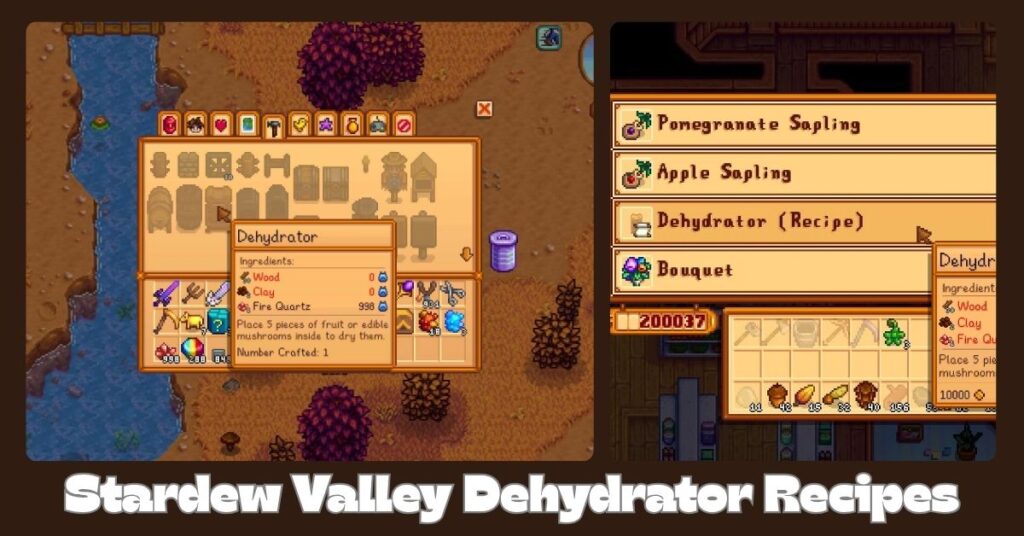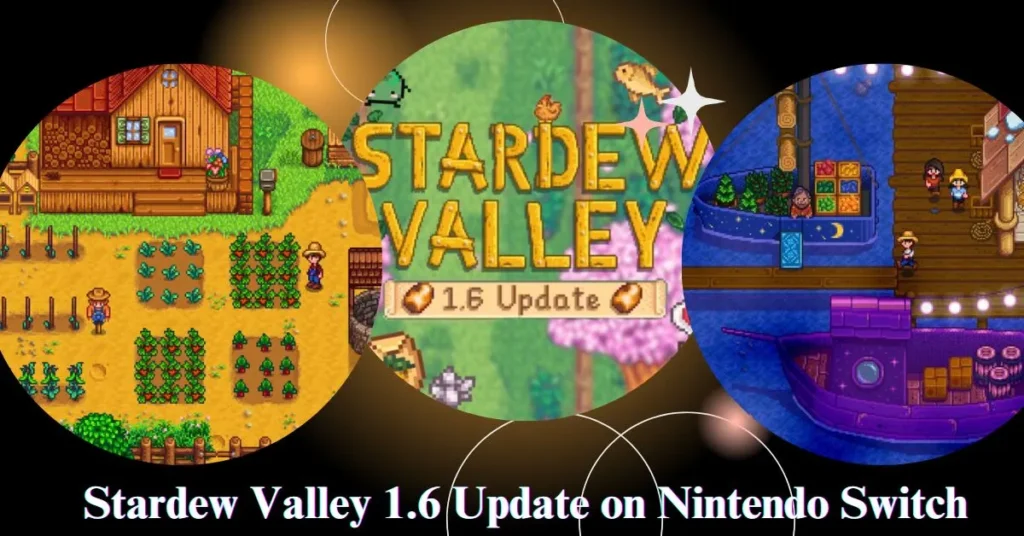The highly anticipated Stardew Valley 1.6 update brought a wealth of new content, and among its most impactful additions for farmers is the Dehydrator. This new piece of artisan equipment offers a fresh avenue for processing your harvests, transforming fresh produce into valuable dried goods. Understanding its mechanics and optimal uses can significantly boost your farm’s efficiency and gold income.
Acquiring Your Dehydrator
Before you can start drying your crops, you’ll need to get your hands on a Dehydrator. There are a few ways to obtain this handy machine:
- Crafting Recipe: The most common method is to purchase the crafting recipe from Pierre’s General Store in Pelican Town for 10,000g. Once purchased, you can craft it using:
-
- 30 Wood
- 2 Clay
- 1 Fire Quartz
- Mushroom Cave: If you opted for the Mushroom Cave when Demetrius offers to upgrade your farm cave, you will automatically receive one Dehydrator for free, allowing you to start preserving your mushroom harvests immediately.
- Prize Machine: There’s also a chance to obtain a Dehydrator as a reward from the Prize Machine located in the Mayor’s Manor.
Dehydrator Mechanics: How It Works
The Dehydrator operates similarly to other artisan equipment like the Keg or Preserve Jar, but with its unique characteristics:
- Input: You must place 5 identical pieces of either Fruit or edible Mushrooms into the Dehydrator per batch. Note that Red Mushrooms are typically inedible and cannot be processed.
- Processing Time: Regardless of the item, each batch takes 1 in-game day (1750 minutes) to process. This fast turnaround time is one of its major advantages.
- Output:
- 5 Fruits (excluding Grapes) yield 1 Dried Fruit.
- 5 Grapes yield 1 Raisin.
- 5 Mushrooms (excluding Red Mushrooms) yield 1. Dried Mushroom.
- Quality: Crucially, the quality of the input item does not affect the quality of the dried output. All dried products from the Dehydrator are always of normal quality. This means you should prioritize using your lowest quality (regular) produce to maximize efficiency, saving higher quality items for direct sale or other artisan goods.
Dehydrator Recipes & Profitability Analysis
The Dehydrator increases the base sell price of the input items. For Dried Fruit and Dried Mushrooms, the output sells for 7.5 times the base price of a single input item, plus an additional 25g. If you have the Artisan Profession, this profit is further boosted, making the Dehydrator even more lucrative.
A. Dried Fruit Recipes
Here’s a look at some common fruits and their approximate sell values when processed through the Dehydrator (values are for one Dried Fruit, made from 5 fresh fruits):
| Fruit Name | Base Value (per item) | Dried Fruit Value (from 5 items) |
|---|---|---|
| Starfruit | 750g | 5,650g |
| Ancient Fruit | 550g | 4,150g |
| Pineapple | 300g | 2,275g |
| Melon | 250g | 1,900g |
| Peach | 140g | 1,075g |
| Blueberry | 50g | 400g |
| Cranberries | 75g | 587g |
- Optimal Fruits: While high-value fruits like Starfruit and Ancient Fruit yield the most gold per batch, the Dehydrator truly shines with high-yield, multi-harvest crops like Blueberries and Cranberries. Their sheer abundance means you can process large quantities quickly, converting what might otherwise be sold raw into more valuable artisan goods.
B. Dried Mushroom Recipes
Mushrooms are another excellent candidate for the Dehydrator, especially if you’ve chosen the Mushroom Cave on your farm.
| Mushroom Name | Base Value (per item) | Dried Mushroom Value (from 5 items) |
|---|---|---|
| Purple Mushroom | 250g | 1,900g |
| Morel | 150g | 1,150g |
| Chanterelle | 160g | 1,225g |
| Common Mushroom | 40g | 325g |
- Optimal Mushrooms: Purple Mushrooms offer the highest profit when dehydrated. Processing any excess mushrooms from your cave or foraging is a great way to monetize them.
C. Raisins (Grapes)
Grapes hold a special place in the Dehydrator’s repertoire. While 5 Grapes yield 1 Raisin (fixed sell price of 600g, or 840g with Artisan), their true value lies in their utility:
- Junimo Hut Fuel: Raisins can be placed in Junimo Huts to increase the efficiency of your Junimos. Each Raisin provides a 20% chance for Junimos to double the crops harvested from nearby tiles, making them incredibly valuable for large-scale farming operations.
D. Profit Comparison: Dehydrator vs. Kegs/Preserve Jars
It’s important to note that for many high-value crops (like Ancient Fruit or Starfruit), Kegs (for Wine) and Preserve Jars (for Jelly) generally offer a higher per-unit profit over a longer processing time.
- Kegs: Typically triple the base value of fruit (e.g., Ancient Fruit Wine). Takes 6.25 days.
- Preserve Jars: Double the base value of fruit/vegetable + 50g (e.g., Ancient Fruit Jelly). Takes 2-3 days.
- Dehydrator: Offers a lower per-unit profit compared to Kegs/Jars, but its 1-day processing time and ability to handle 5 items at once make it superior for volume and speed.
When to use the Dehydrator:
- High-Volume Crops: Ideal for crops like Blueberries and Cranberries, where you have massive quantities and want to process them quickly.
- Early Game: It’s accessible earlier than Kegs (Farming Level 8) and Preserve Jars (Farming Level 4), making it a great early-game money maker.
- Overflow Processing: When your Kegs and Preserve Jars are full, the Dehydrator is perfect for converting excess produce into a profit rather than selling it raw.
- Mushrooms: It’s the only artisan machine for mushrooms, making it the go-to for increasing their value.
Below we have added a video, so that it will be easier for our beloved gamers to make the recipes-
Strategic Applications & Advanced Tips
- Prioritize Low Quality: Always feed your Dehydrator with regular quality fruits and mushrooms, as the output quality is fixed. This saves your higher-quality produce for direct sale or other artisan goods.
- Mushroom Cave Synergy: If you have the Mushroom Cave, place a Dehydrator nearby to easily process your daily mushroom harvest for consistent income.
- Junimo Hut Power-Up: For large farms with Junimo Huts, a dedicated grape farm and Dehydrators for Raisin production can significantly boost your overall crop yield.
- Early Game Gold: Crafting a Dehydrator early can provide a steady income stream before you’ve built up a large artisan goods empire with Kegs and Preserve Jars.
- Space Management: Consider placing Dehydrators in sheds or on Ginger Island to maximize processing capacity without cluttering your main farm.
Conclusion
The Dehydrator is a fantastic addition in Stardew Valley 1.6, offering a fast and efficient way to increase your farm’s profitability. While it may not always yield the highest per-unit profit compared to other artisan equipment, its speed, volume capacity, and unique utility (especially for mushrooms and Raisins) make it an indispensable tool for any aspiring farmer looking to maximize their earnings and streamline their operations. Embrace the Dehydrator, and watch your dried goods pile up!
Disclaimer: Game mechanics and values are based on Stardew Valley version 1.6. This information is accurate as of the last major update but is subject to change with future game patches. Profit calculations are based on base item values and may vary based on in-game skills (e.g., Tiller, Artisan professions), daily luck, and specific in-game events. Always verify current game data for the most up-to-date information.



